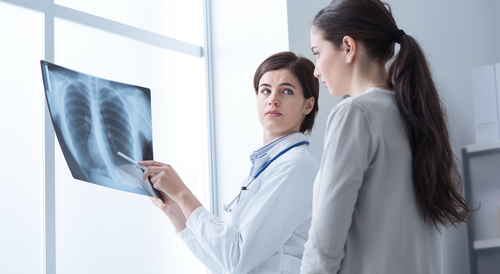Recovering from Pneumonia with SMA: How Diaphragmatic Breathing and Abdominal Strengthening Aides Recovery

According to the article “Spinal Muscular Atrophy1,” “with SMA the spared diaphragm, combined with weakened intercostal muscles, results in paradoxical breathing. Also with the involvement of bulbar motor neurons often tongue fasciculation, poor suck and swallow with increasing swallowing and feeding difficulty overtime.” A cause of death could be aspiration pneumonia.1 For this reason, during treatment, it is important to integrate diaphragmatic breathing. The diaphragm is a very important muscle that assists in respiration. Since the diaphragm is a muscle, you can improve the strength, coordination, endurance and neuromuscular control with simple exercises.
Regarding my experience with the importance of diaphragmatic breathing, I have had the pleasure of working with a patient with Spinal Muscular Atrophy. We have been working together for the last year for one visit a week with focus on posture, core stability, cervical stability, and early in his rehabilitation, diaphragmatic breathing. We initially started exercises such as; quick breathes for time, long deep breathes while sitting upright, and lumbar flexion with focus on breathing.
My patient was recently admitted to the emergency room because he had an extremely high fever and was diagnosed with pneumonia. As mentioned in the article “Spinal Muscular Atrophy and Breathing Difficulties,” it is very common for people with SMA to have “respiratory complications, including those due to lung underdevelopment and weak cough.” He was discharged from the hospital three days later.
We decided it was best for him to take two weeks off to focus on healing and resting. Upon his return, we completed a re-evaluation to determine if he has lost any strength. His only noticeable decrease in strength were in his abdominals. During his re-evaluation, the patient noted to me that he had no residual congestion or coughing since his release from the hospital two and a half weeks ago. According to lung.org, it can take a week for a healthy individual to recover from pneumonia. Typically, at one week their fever should desist. Week four, their chest should feel better and produce less mucus. Week six, it should be easier to breath with less coughing. At 3 months, their symptoms should be almost gone with some fatigue. At six months, their symptoms should be completely gone.2
To continue with his rehabilitation and to prevent any further respiratory problems, we have resumed Physical Therapy slowly. We will continue engaging his core and abdominal strengthening with focus on diaphragm breathing. We believe that because of his physical therapy exercises and focus on abdominal strengthening, we have reduced his healing time drastically, thus demonstrating the importance of physical therapy in a patient diagnosed with Spinal Muscular Atrophy.
——–
- Orphanet J Rare Dis. 2011; 6: 71.
Published online 2011 Nov 2. doi: 10.1186/1750-1172-6-71
Spinal muscular atrophy
Adele D’Amico,1 Eugenio Mercuri,2 Francesco D Tiziano,3 and Enrico Bertini
- https://www.blf.org.uk/support-for-you/pneumonia/recovery
- https://www.lung.org/lung-health-and-diseases/lung-disease-lookup/pneumonia/diagnosing-and-treating.html

